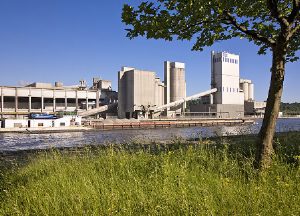 |
| HeidelbergCement’s Lixhe Plant in Belgium. |
HeidelbergCement launched a promising project in the field of sustainable cement manufacturing. A cutting-edge testing facility is to be set up at its at its Lixhe plant in Belgium to comprehensively assess new technology for the capture of CO2.
The project is taking place under the auspices of the LEILAC (Low Emissions Intensity Lime and Cement) consortium. The research consortium includes HeidelbergCement, the Australian technology company Calix and other cement and lime producers, as well as research and development institutions.
The LEILAC project aims to help the European industry to achieve emissions reduction targets effectively and economically. Calix’s Direct Separation process provides a common platform for carbon capture in both the lime and cement industries. This can help these sectors to thrive in the face of tighter international CO2 emissions regulations, where the only options may be to capture and store CO2 instead of emitting it into the atmosphere.
Two-thirds of CO2 emissions from cement and lime production are generated through the breakdown of limestone into lime and CO2 in furnaces. Calix’s technology re-engineers the existing process flows, where it is capable of capturing almost pure CO2 released from the limestone – potentially with no additional energy costs or environmental impact.
The system design is unique, as the furnace exhaust gases are not in direct contact with the limestone. In this indirectly heated reactor, the energy from the heating gases is transferred to the limestone via a special steel vessel. The CO2 released from the limestone can therefore be separated in an almost pure form. The technology is complementary with other carbon capture methods already developed in the power and cement sector, such as oxyfuel, and can make use of alternative fuels.
The project will run for five years. During the first three years, the project will focus on finalizing the design of the demonstration plant, to be constructed at the Lixhe plant once the necessary permits have been secured. The pilot unit will then undergo two years of extensive testing in a standard operational environment at a feed rate capacity of 240 tpd of cement raw meal and 200 tpd of ground limestone, respectively, on a continuous basis for several weeks.
The fundamental research on the process demands and performance aims to demonstrate that the technology works sufficiently to begin scale-up planning. The project’s results will be shared widely through ongoing publications, conferences and this website.
To accelerate further development, LEILAC will deliver a techno-economic roadmap, and comprehensive knowledge sharing activities including a visitor center at the pilot.
The project has been awarded €12 million in funding from the EU as part of Horizon 2020, an EU research and innovation program.

